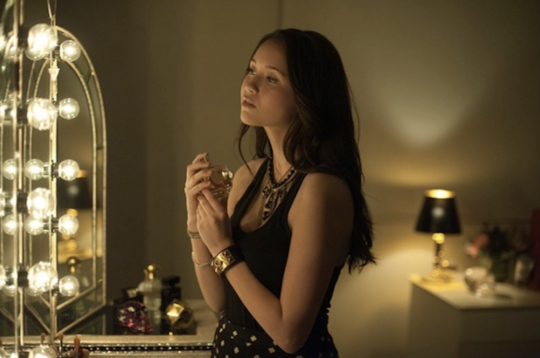Mirror, Mirror: When Movie Characters Look Back at Themselves by Sheila O’Malley
By Yasmina Tawil
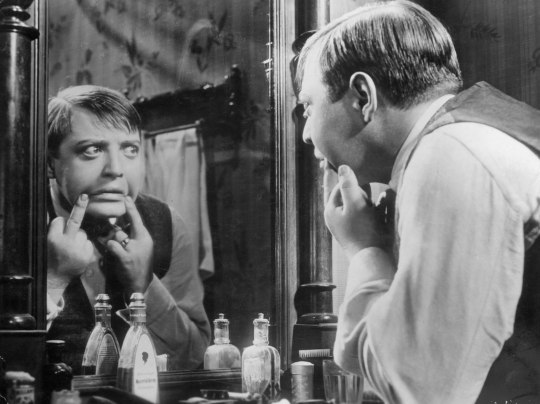
“I always feel it behind me. It’s myself. And I follow me. In silence. But I can hear it. Yes, sometimes it’s like I’m chasing myself. I want to escape from myself. But I can’t!” —Peter Lorre as child-murderer, M (1931)
There was a period in the ‘60s and ‘70s when you could barely call yourself a male movie star if you didn’t do a scene where you stared at yourself in the mirror, doing various “private” things. The device shows up before then, too, but the floodgates opened in the ‘60s and ‘70s. Meryl Streep has observed, “Often the scenes that are the most exciting, and most illuminating in film, are the ones with no dialogue…where a character is doing something alone, where the deepest most private self is revealed or explored. Exposed.”
Mirrors have multiple thematic uses (as well as the obvious directorial choice to add visual interest to the frame). But if a character is inarticulate, then seeing him “deal with” his reflection can fill in some gaps. It’s a great storytelling shortcut. If the character has a firm public “mask,” a “mirror scene” can let us see who he is when no one is watching. We all lie, to some degree, out there in the world (or on social media). We construct a “self” and a mirror scene allows the character to strip that away.
Speaking stereotypically (or, in archetypes), what is expected of male characters in terms of public persona is different from the pressures on female characters. Not better or worse, just different. Crying, showing uncertainty, weakness, vulnerability … can be a minefield. This is why the glut of male mirror scenes in the 70s makes a kind of sense: as the women’s movement rose, men began to wonder about their place, as well as buck against some of the gender norms imposed on them (or, in some cases, re-entrench said gender norms, Travis Bickle’s “You talkin’ to me” the most classic example).
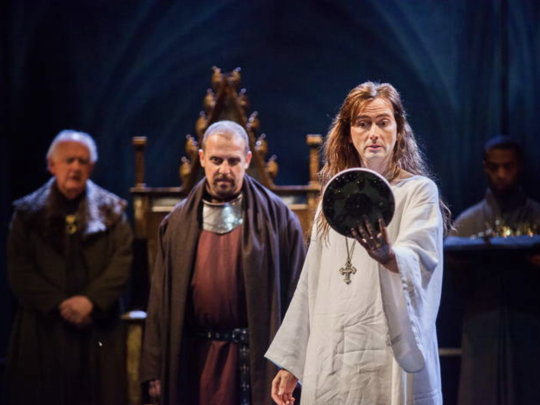
Shakespeare’s use of the soliloquy—in particular for Kings and prospective Kings—could be seen as mirror scenes, with the audience as the mirror. A man goes into a private space, showing the audience things he cannot show on the battlefield or in the court. Hamlet, one of the most introverted of Shakespeare’s characters, showing non-gender-norm qualities of uncertainty and sensitivity, has a massive six soliloquies. (“O that this too too solid flesh would melt”, “O what a rogue and peasant slave am I”, “To be or not to be”, “Tis now the very witching time of night”, “Now might I do it pat” and “How all occasions do inform against me.”) It is impossible to imagine the play—or Hamlet—without them. In Richard II, after Richard is forced to surrender his crown, what is the first thing he does? Like a true narcissist, he calls for a mirror. As he stares at himself, he wonders,
“Was this face the face
That every day under his household roof
Did keep ten thousand men?”
and throws the mirror on the ground.
Mirrors are powerful and mysterious symbols. The doubling-up can mean all kinds of things. Alice steps through the looking glass into another world. Goethe’s Faust looks into the witch’s mirror and sees a beautiful woman staring back. Dorian Gray takes a mirror to compare his face with the one in the attic portrait. (Like Richard III, Dorian smashes the mirror.) A mirror is crucial in Tennyson’s “The Lady of Shalott,” where “The Lady” is cursed to view the world only through a mirror. But then Lancelot rides by and she can’t help it, she has to sneak a peek. Maybe the most famous fictional mirror is the Evil Queen’s in “Snow White,” the one she asks every day, “Mirror, mirror, on the wall, who’s the fairest of them all?” Richard III doesn’t look for a reflection of his beauty. He wonders where his “self” even is, without the crown.
An early male mirror scene—and one of the best—is Peter Lorre’s in Fritz Lang’s M (1931). Our first glimpse of Lorre’s face comes without warning. As a handwriting-analyst theorizes in voiceover about the child-killer’s psychology, we see him, staring at himself in the mirror. He pulls at his face, slowly, manipulating his mouth into a smile, trying it on for size, maybe seeing what it looks like to the children he seduces. He bugs his eyes out, turning this way, that, a maniacal presence, almost like a shark rolling its eyes backwards as it attacks. He has no sense of what human beings feel like, of what he looks like, of how to even make a facial expression. It’s one of the most chilling private moments in cinema.

Speaking of “private moments”: Constantin Stanislavski wrote a lot about how actors needed to feel “solitude in public.” He wrote: ”During a performance, before an audience of thousands, you can always enclose yourself in this circle…You can carry it with you wherever you go.” Lee Strasberg developed his “private moment exercise” to help actors achieve “solitude in public.” There are things you do when you are alone which you would stop doing if someone walked in. Maybe you sing along to the radio. Maybe you talk to yourself. Maybe you pick your nose. Maybe you do all of these things simultaneously. Our “public” selves are drilled into us from a very young age. There are “good manners,” there are “contexts” to be memorized—what flies at home will not fly outside the home. Breaking down the public face, letting an audience see who you are when you are by yourself, is part of the actor’s job. (It’s not a surprise that the ‘70s came to be dominated by private-moment mirror scenes, considering the influence of the Strasberg method on acting styles.)
One of the most important mirror scenes, and a huge influence on Martin Scorsese, is Marlon Brando’s in Reflections in a Golden Eye, directed by John Huston. Brando plays Major Weldon Penderton, a closeted gay man married to a frustrated, luscious Elizabeth Taylor. Late at night, Penderton sits alone, staring at pictures of naked male statues from Greek antiquity. The character lives in an almost totally male world (the military), turned on by young soldiers, and terrified of revealing himself. In one scene, alone downstairs in the house, he walks into the hall and stares at himself in the mirror. After a moment of vacuity, he begins to talk to himself, or, more vulnerably, to an imaginary other person. He pretends to respond to what the other person says, he practices laughing, and he smiles, but the smile is superimposed. He can’t get it to look real. What he says is a kind of murmur, a “pretense” of conversation. This is the kind of vulnerability Brando could achieve like no other. Without this scene, the Major could have been a caricature. All we see is his fuddy-duddy sexless stiff public mask. The mirror scene shows his confusion at how to be a man, how to navigate even a casual conversation.

Alain Delon has a stunning mirror moment in Purple Noon (1960), Rene Clement’s adaptation of Patricia Highsmith’s The Talented Mr. Ripley. Delon plays the sociopath Tom Ripley, in thrall to his casually masculine friend Philippe Greenleaf (Maurice Ronet). Delon’s chilly presence onscreen works to beautiful effect: He doesn’t show us much. But then, he tries on Philippe’s clothes, a sleek pinstripe jacket, fancy shoes. He checks himself out in the mirror. Most actors would leave it at that. But Delon understood the homoerotic implications of the script, not to mention the character’s dangerous narcissism. Delon leans into the mirror and gives himself a rapturous long kiss, slitting his eyes open at one point, to check out what he looks like.
It’s interesting to contrast this with the same scene in the 1999 adaptation, The Talented Mr. Ripley, starring Matt Damon. Director Anthony Minghella makes the subtext practically text, by placing mirrors in almost every scene (the final shot of Ripley is through a mirror). When Ripley tries on his friend’s clothes, he dances around to Bing Crosby’s “May I,” doing a vaudeville burlesque. It’s a different kind of rapture than Delon’s swooning kiss. Damon’s drag-style dance is more for the audience, an explicit display of inner gay-ness, what Ripley is hiding beneath his good-natured submissive public persona. It’s a good scene, although I prefer Delon’s. Delon’s kiss is Stanislavsky’s “public solitude”—and it shows the terrifying void within the character. There is no self. The entire world is a mirror.
In Karel Reisz’s gritty Saturday Night and Sunday Morning, Albert Finney’s Arthur, in a whirl of work, sex, and alcohol, is suddenly caught by his reflection one hungover morning. He was beat up the night before. He plays at being a sniper through his window, targeting local women with pellets. It’s a thin line between playfulness and murderous acting-out. Finney digs into this aspect of the character when he suddenly speaks to his reflection. It is a statement of bravado before descending into confusion: ”I’m me and nobody else. Whatever people say I am that’s what I am not, because they don’t know a bloody thing about me. God knows what I am.”

For the opening sequences of Rocky, we see Rocky Balboa’s normal “day in the life.” We are introduced to him through various public selves. But when he goes home to his dank apartment, feeding his turtles, gentle and quiet, his loneliness is so acute it reverbs off the screen. Childhood photographs of him line the mirror frame, and Rocky stares at them, his big-lug face almost crushed in disappointment. Holding a container of turtle food, he starts to talk to himself. What he’s saying doesn’t sound like anything, just private-moment murmurings, but in the next scene, when he goes to visit the girl in the pet store, it becomes clear. He was practicing a joke to tell her, a joke designed to make her laugh, show her he’s a safe person, he’s nice. Rocky practicing a joke in the mirror is one of Stallone’s most vulnerable moments as an actor (and evidence of his gift as a screenwriter).
John Travolta’s mirror moment in 1977’s Saturday Night Fever is star-making, not just because of Travolta’s almost otherworldly gorgeousness (as well as how he revels in said gorgeousness, behavior considered coded-female). Surrounded by 1970s icons—posters of Rocky, Serpico, and Farrah Fawcett—he blow-dries his hair, places gold chains around his neck, and stands like a superhero in his black speedo briefs, shot from below. Perhaps the most revealing thing about the scene is that when his father barges into the room, Travolta’s Tony Manero does not stop what he is doing. His lack of embarrassment tells us everything we need to know about the character.
Francis Ford Coppola’s epic, Apocalypse Now begins with a hallucinatory sequence showing a PTSD-rattled Martin Sheen, holed up in a hotel room in Saigon, tormented by memories. In one shocking moment, Sheen stands unsteadily, and lurches around in front of the mirror, flailing his arms out in imitation martial-arts moves, an attempt to combat his helplessness and anguish, his impotence. But the gap between reality and fantasy is too great, and he, like Richard III, smashes the mirror.
Richard Gere’s mirror moment in American Gigolo is a distant cousin of John Travolta’s. His Julian has carefully crafted an immaculate persona for his female clients, and part of the movie’s pull is watching it get stripped away. At home, Julian wanders around, practicing Swedish, working out, picking out clothes for his next appointment. He’s vain, but vanity is part of his job. Smokey Robinson’s “The Love I Saw In You Was Just a Mirage,” and it’s perfect because Julian literally is a mirage. To his clients, to himself, even. When he stands in front of the mirror, flexing his muscles, he is more Evil Queen than Richard III, a destabilizing of gender norms around male sexuality (and self-presentation) which is so much a part of the film. (When Julian meets a private detective, it’s at a joint called the Me & Me Coffee Shop. Julian’s hall of mirrors shatters by the end of American Gigolo: in the final scene, he talks to Lauren Hutton through a glass partition in prison. The mirror is no more. He can see through it now to the other person, and, crucially, he can be seen, too, as he really is.)
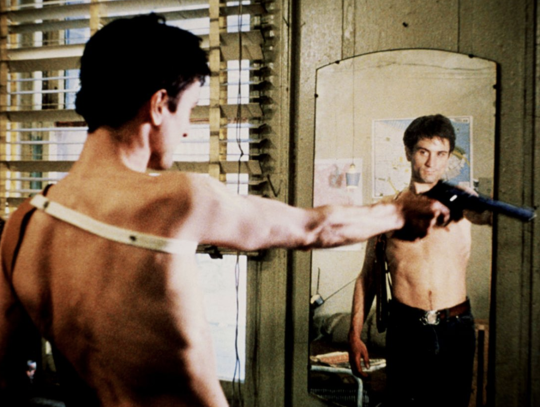
The most famous mirror moment is, of course, Robert De Niro’s in Taxi Driver. In the insomniac voiceover, his Travis Bickle says, “I think that someone should become a person like other people,” showing the character’s alienation from other humans. You aren’t already a person, to Travis: you have to become one. As Travis descends into psychosis, dreaming of 1. impressing the cool blonde (Cybill Shepherd) who rejected him after he took her to a porn movie on their first date and 2. rescuing the child prostitute Iris (Jodie Foster), he begins to amass a small arsenal, putting together boot holsters and straps to go around his wiry body. In the unforgettable moment when he checks himself out in the mirror, he goes into a zone of macho fantasy. (Schrader’s script said only “Travis speaks to himself in the mirror.” De Niro’s “You talkin’ to me” was his improvisation.) De Niro goes so far into his sense of privacy, it’s almost embarrassing to watch. And yet it’s so human, too. (If you say you’ve never talked to yourself in the mirror, or sung in the shower, you’re lying.)
De Niro’s second mirror moment is Raging Bull’s final scene, when the bloated Jake La Motta recites Marlon Brando’s “I coulda been a contender” monologue from On the Waterfront, before standing up and doing a series of “pumping up” exercises, to get ready to go onstage. (Side note: Mary Elizabeth Winstead closes out Eva Vives’ wonderful 2018 film All About Nina, about a troubled stand-up comic, with a re-creation of the scene from Raging Bull.) What’s fascinating about the Raging Bull scene is that Jake La Motta has no “self” to reveal. It’s almost like there’s no inner life at all. He doesn’t “get it.” He never did, he never will. De Niro blanks himself out in a very unnerving way, opposite to the dangerous vengeful-spirit fantasy he inhabits in Taxi Driver.
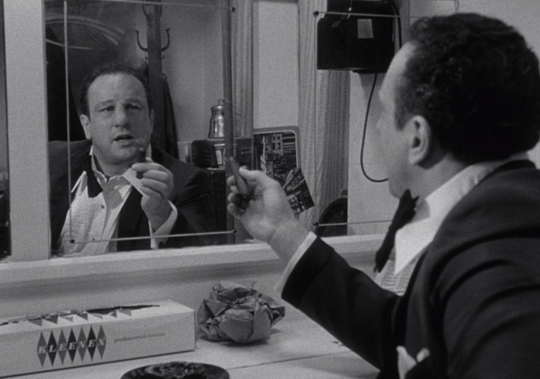
Although Walter Hill’s Johnny Handsome descends into a cliched crime movie with paper-thin characters, the opening sequences are dark, cynical, and atmospheric. Mickey Rourke plays Johnny, a man with a deformed head, an “ugly” appearance which has separated him from other humans. Reminiscent of the Joan Crawford film A Woman’s Face, a caring plastic surgeon (Forest Whittaker) offers to operate on Johnny, to give him a chance at a new life. When Rourke unwraps the bandages and sees his new face (i.e. Rourke’s real face), Rourke has a mirror moment like almost no other, a moment worthy to be placed alongside Brando’s and De Niro’s. He touches his face with wonder, bursting into tears. That’s touching enough, but then, as he glances back at Whitaker, Rourke goes deeper. A look of fear, and lifelong anguish floods his eyes, as he says, “I feel like I still have a mask on” and then, after that, Rourke goes even deeper into a maelstrom of emotion: gratitude, bafflement, awe, despair. The scene is Rourke’s finest hour.
Up until recently (with a couple of exceptions), when women stared at themselves in the mirror in the movies, it was obvious what they are doing: touching up their makeup, checking out their mask. Once again, in the 1960s and 70s, women started doing “mirror scenes” equivalent to men’s mirror scenes, where the purpose was not perfecting the public mask, but to - as Sylvia Plath wrote in her poem “Mirror” - search “my reaches for what she really is.” Faye Dunaway has a great one in Jerry Schatzberg’s Puzzle of a Downfall Child. Gena Rowlands has quite a few “mirror scenes” in the movies she did with Cassavetes (there’s a couple of stunners in Opening Night). In my favorite moment in Sofia Coppola’s The Bling Ring, after breaking into Paris Hilton’s house, Katie Chang goes into a daze of mad-woman fantasy, staring at herself in Paris’ mirror. It’s not hard to imagine the character slipping into the Manson family, if a Manson came along. She’s as blank as Jake La Motta. In La Verite’s opening scene, Brigitte Bardot stares at her face in a broken shard of a mirror, right before marching off for her court date. Her “self” is fragmented, broken. Jennifer Jason Leigh has an extraordinary extended “mirror scene” in Georgia. The moment is everything: self-hatred, rage, searching and longing, and bone-deep narcissism.

Men staring at themselves in the mirror let us into their secret worlds, their fantasies and anxieties, uncertainties and vulnerabilities. It’s not about being self-obsessed. It’s trying to find the self, the self that is not allowed free rein, be it a benign self or a malevolent one.
In Caravaggio’s “Narcissus,” Narcissus leans towards his reflection in the water, his posture pulled downwards with a seductive tug. He braces himself by his hands on the ground, and his knee, bulging out beneath his torso, is the only barrier between Narcissus and his reflection (and, perhaps, drowning). In the painting the reflection below is cut off; all we see are the forearms and that gleaming sturdy knee. Even though Narcissus’ body is barely visible, even though he’s hunched over himself, his energy is childlike, soft and open. He gives his reflection a caressing stare, a swooning look. He yields. This is not just vanity. This is something else.
